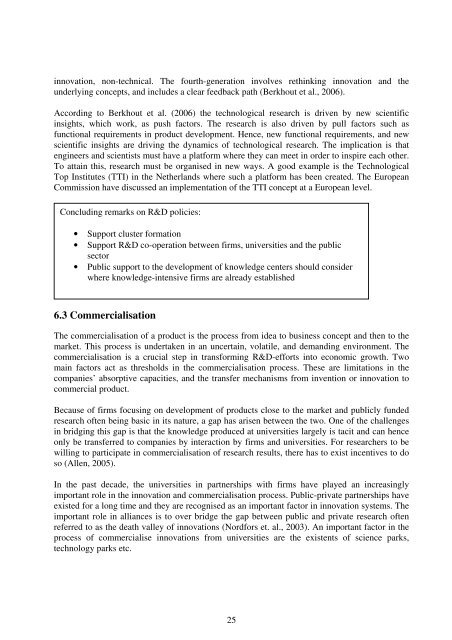INNOVATION POLICY INSTRUMENTS
INNOVATION POLICY INSTRUMENTS
INNOVATION POLICY INSTRUMENTS
You also want an ePaper? Increase the reach of your titles
YUMPU automatically turns print PDFs into web optimized ePapers that Google loves.
innovation, non-technical. The fourth-generation involves rethinking innovation and the<br />
underlying concepts, and includes a clear feedback path (Berkhout et al., 2006).<br />
According to Berkhout et al. (2006) the technological research is driven by new scientific<br />
insights, which work, as push factors. The research is also driven by pull factors such as<br />
functional requirements in product development. Hence, new functional requirements, and new<br />
scientific insights are driving the dynamics of technological research. The implication is that<br />
engineers and scientists must have a platform where they can meet in order to inspire each other.<br />
To attain this, research must be organised in new ways. A good example is the Technological<br />
Top Institutes (TTI) in the Netherlands where such a platform has been created. The European<br />
Commission have discussed an implementation of the TTI concept at a European level.<br />
Concluding remarks on R&D policies:<br />
• Support cluster formation<br />
• Support R&D co-operation between firms, universities and the public<br />
sector<br />
• Public support to the development of knowledge centers should consider<br />
where knowledge-intensive firms are already established<br />
6.3 Commercialisation<br />
The commercialisation of a product is the process from idea to business concept and then to the<br />
market. This process is undertaken in an uncertain, volatile, and demanding environment. The<br />
commercialisation is a crucial step in transforming R&D-efforts into economic growth. Two<br />
main factors act as thresholds in the commercialisation process. These are limitations in the<br />
companies’ absorptive capacities, and the transfer mechanisms from invention or innovation to<br />
commercial product.<br />
Because of firms focusing on development of products close to the market and publicly funded<br />
research often being basic in its nature, a gap has arisen between the two. One of the challenges<br />
in bridging this gap is that the knowledge produced at universities largely is tacit and can hence<br />
only be transferred to companies by interaction by firms and universities. For researchers to be<br />
willing to participate in commercialisation of research results, there has to exist incentives to do<br />
so (Allen, 2005).<br />
In the past decade, the universities in partnerships with firms have played an increasingly<br />
important role in the innovation and commercialisation process. Public-private partnerships have<br />
existed for a long time and they are recognised as an important factor in innovation systems. The<br />
important role in alliances is to over bridge the gap between public and private research often<br />
referred to as the death valley of innovations (Nordfors et. al., 2003). An important factor in the<br />
process of commercialise innovations from universities are the existents of science parks,<br />
technology parks etc.<br />
25
















